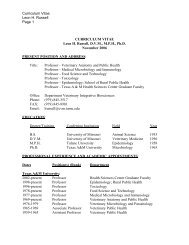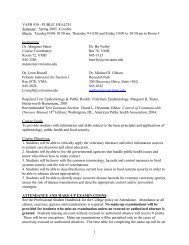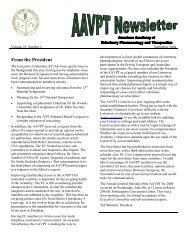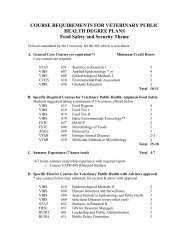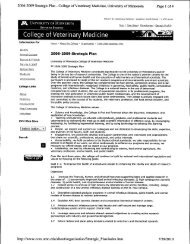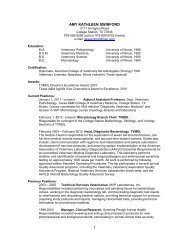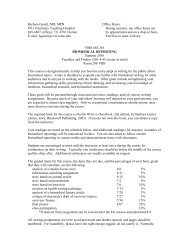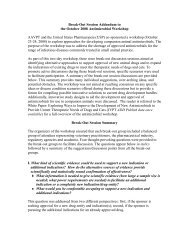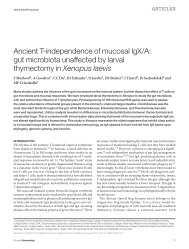View PDF - College of Veterinary Medicine - Texas A&M University
View PDF - College of Veterinary Medicine - Texas A&M University
View PDF - College of Veterinary Medicine - Texas A&M University
Create successful ePaper yourself
Turn your PDF publications into a flip-book with our unique Google optimized e-Paper software.
family in the analysis and are consistent with the hypothesis that<br />
the S100 pseudo EF hand evolved after the canonical EF-hand [13].<br />
The individual Ca 2+ sensor protein families (NSLC, CABP,<br />
CaM/TnC and parvalbumin) each fell into their own clade. Furthermore,<br />
subgroups/subfamilies emerged within the S100 family:<br />
A2/A3/A4/A5/A6 was strongly supported by both trees, and<br />
subgroups <strong>of</strong> A13/A14/A16, A7s/A8/A9/A12/G, and A1/A11/B/P/Z<br />
showed progressively weaker conservation in these two species.<br />
Members within these subgroups were largely located in juxtaposition<br />
to one another in the genome, suggesting that a series<br />
<strong>of</strong> tandem gene duplications contributed to the expansion <strong>of</strong> the<br />
S100 family. The older natural history between these groups was<br />
difficult to determine because, although each <strong>of</strong> the subfamilies<br />
forms clades, there was little statistical support from the bootstrap<br />
iterations for deeper relationships between the groups.<br />
3.2. Genomic organization<br />
As a first step in establishing the molecular evolution <strong>of</strong> the<br />
S100s, we expanded our analysis to include additional mammalian<br />
species. Since S100 expression is regulated at the epigenetic level<br />
[39], genomic rather than EST data was used to collect the complement<br />
<strong>of</strong> S100 family members encoded in the following select<br />
mammalian genomes (Table 1). The platypus was selected to represent<br />
the oldest egg-laying mammals (the monotremes), and the<br />
opossum was chosen as the most complete marsupial genome.<br />
Molecular phylogenetics suggests two major branches <strong>of</strong> extant<br />
placental mammals, and species from the two major bifurcations<br />
<strong>of</strong> each branch were included [40]. The Atlantagenata yielded<br />
Xentharthra (represented here by the armadillo) and Afrotheria<br />
(represented by the elephant). The Boreoeutheria included Lauraiatheria<br />
(represented by cow and dog) and the Euarchontoglires<br />
(represented by the mouse and human). Like the human and mouse,<br />
S100 family members in dog, cow, elephant, and opossum are<br />
encoded at six regions: S100As in two different regions on a single<br />
chromosome and S100B, S100P, S100G, and S100Z on four other<br />
chromosomes (Supplemental Figs. 1–6). With only minor exceptions,<br />
the genomic organization <strong>of</strong> S100 family members was highly<br />
conserved in mammals. These data are in agreement with previous<br />
studies, the only exception being earlier reports that the canine<br />
S100A cluster is located on a different chromosome from that <strong>of</strong><br />
other mammals [41]. While a detailed analysis <strong>of</strong> the organization<br />
<strong>of</strong> individual S100 genes was beyond the scope <strong>of</strong> this study, it<br />
should be noted that the position <strong>of</strong> intron/exon boundaries relative<br />
to 5 ′ UTRs, initiation codons and coding sequences was quite<br />
variable and not as highly conserved as was indicated prior to the<br />
completion <strong>of</strong> the mouse and human genomes [42].<br />
In all mammalian species, S100A11 and S100A10 were located<br />
in tandem adjacent to the SFTP genes (Supplemental Fig. 1). Adjacent<br />
genes on both sides were conserved as well. However, there<br />
were gene insertions between the SFPTs and neighboring genes<br />
in both the mouse (7 genes) and human (13 genes) genomes.<br />
The mouse genome also contained a four-gene insertion between<br />
S100A10 and its conserved neighbor THEM4. The opossum genome<br />
encoded an additional S100A10 on chromosome 4, referred to as<br />
S100A10(2), that was not found in any other species including the<br />
Australian marsupials (wallaby or Tasmanian devil). S100A10(2)<br />
was not detected in any “higher” mammals or the “lower” platypus<br />
by nearest neighbor analysis. The proteins encoded by these<br />
loci differed by 17 (out <strong>of</strong> 97) amino acids. Their pairwise matrix<br />
amino acid identity score (0.254) was much lower than scores for<br />
other opossum S100s (0.601–3.201), suggesting that S100A10(2)<br />
arose from an S100A10 gene duplication/translation event (Fig. 4).<br />
Finally, opossum ESTs were not detected for either loci; therefore<br />
we could not conclude that these genes were expressed.<br />
D.B. Zimmer et al. / Cell Calcium 53 (2013) 170– 179 173<br />
The S100A1-A100A16 loci were located on the same chromosome<br />
in all species and exhibited several interesting changes<br />
(Supplemental Fig. 2). The A1/A13/A14/A16 cluster was intact in<br />
all mammalian species for which complete contigs were available.<br />
The only change in the A8/A9/A12 cluster was the loss <strong>of</strong> S100A12<br />
in the mouse. Changes in the A2/A3/A4/A5/A6 cluster included a<br />
translocation <strong>of</strong> S100A5 in the dog, loss <strong>of</strong> S100A6 in the cow, and<br />
loss <strong>of</strong> S100A5 and S100A2 in the opossum. The largest number<br />
<strong>of</strong> changes occurred in the S100A7 loci. Mouse, dog, and opossum<br />
genomes contained a single S100A7 gene (S100A7A) while<br />
the human, cow, and elephant genomes contained three S100A7<br />
loci. Subsequent phylogenetic analyses <strong>of</strong> all mammalian S100s<br />
(Section 3.3) revealed that the human locus annotated as S100A7A<br />
actually encodes an S100A7-like protein, referred to as S100AL73,<br />
suggesting another duplication in this cluster.<br />
The remaining four S100 genomic loci encoding singletons were<br />
also highly conserved. The S100B locus was present in all species<br />
except the opossum (Supplemental Fig. 3). The platypus represented<br />
a more ancient clade but contained S100B, although there<br />
has been a block inversion <strong>of</strong> a set <strong>of</strong> genes flanking prmt2 that<br />
neighbor S100B. These results suggest that the loss <strong>of</strong> S100B is<br />
confined to the marsupial lineage. The S100B gene was found in<br />
two divergent Australian marsupials, although on an orphan contig<br />
without the commonly syntenic prmt2 and dip2a. Thus, the loss<br />
<strong>of</strong> S100B may be confined to the American marsupials or even a<br />
smaller evolutionary group including the short-tailed opossum.<br />
S100G was not present in platypus, but was found in all other<br />
species with minor changes in nearest neighbors (Supplementary<br />
Fig. 4). The lack <strong>of</strong> platypus S100G sequences and the strong conservation<br />
<strong>of</strong> syntenic genes on this well assembled portion <strong>of</strong><br />
the platypus genome suggest that S100G emerged in the marsupials<br />
and little has changed since then. The S100P locus had<br />
more checkered presentation in the assayed mammalian genomes<br />
(Supplementary Fig. 5). It was lost in mouse, cow, and elephant<br />
where nearest neighbors were conserved. In contrast to the plasticity<br />
<strong>of</strong> S100P, S100Z is maintained with high fidelity in mammalian<br />
genomes. All mammals examined contained an S100Z locus and the<br />
location within the genome did not change (Supplementary Fig. 6).<br />
3.3. Mammalian S100 tree<br />
Next we performed phylogenetic analysis <strong>of</strong> mammalian S100s,<br />
excluding other Ca 2+ sensors, to determine the relationship among<br />
various S100 family members (Fig. 2). This analysis confirmed the<br />
two subgroups observed in the human and mouse trees (Fig. 1):<br />
A2/A3/A4/A5/A6 and A13/A14/A16. In addition, two other subgroups<br />
emerged: A7s/A8/A9/A12/G and A1/A10/A11/Z/B/P. Three<br />
<strong>of</strong> these subgroups are clustered within the genome, suggesting<br />
that these subfamilies arose by tandem gene duplication events<br />
before the rise <strong>of</strong> mammals. These subgroups may also have<br />
structural and functional significance (Fig. 3). Members <strong>of</strong> the<br />
A7/A8/A9/A12 subgroup have demonstrated antimicrobial activity<br />
and play a major role in innate immunity [43]. Members <strong>of</strong><br />
the A2/A3/A4/A5/A6 and A1/A10/A11/Z/B/P subgroups have aromatic<br />
residues at the carboxyl termini that participate in target<br />
protein interactions [44,45]. In addition, four members <strong>of</strong> the<br />
A2/A3/A4/A5/A6 subgroup have amino acids with large side<br />
chains at position 85 and a charged side-chain at position 49<br />
(using S1004 numbering) that impact 3D structure [46]. However,<br />
other attributes that contribute to S100 diversity such as affinity<br />
for divalent metals, oligomerization properties, post-translational<br />
modification(s), surface charge density, target protein pr<strong>of</strong>ile and<br />
spatial/temporal expression patterns do not appear to be subgroup<br />
specific. For example, S100B is negatively charged and S100A10<br />
is neutral, but both are in the same subgroup [15]. S100A4 and<br />
S100P are in different subgroups, but both regulate myosin filament




